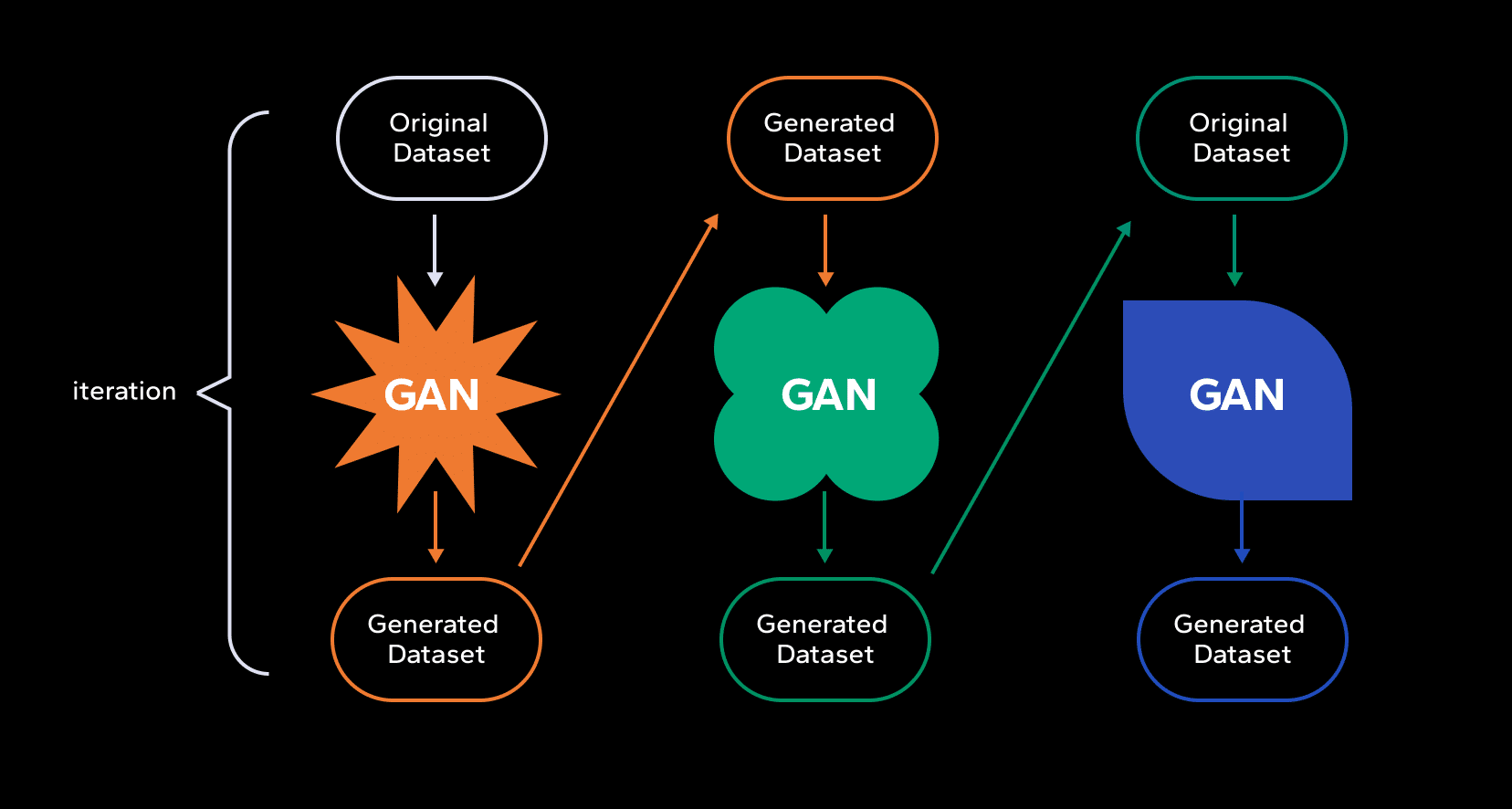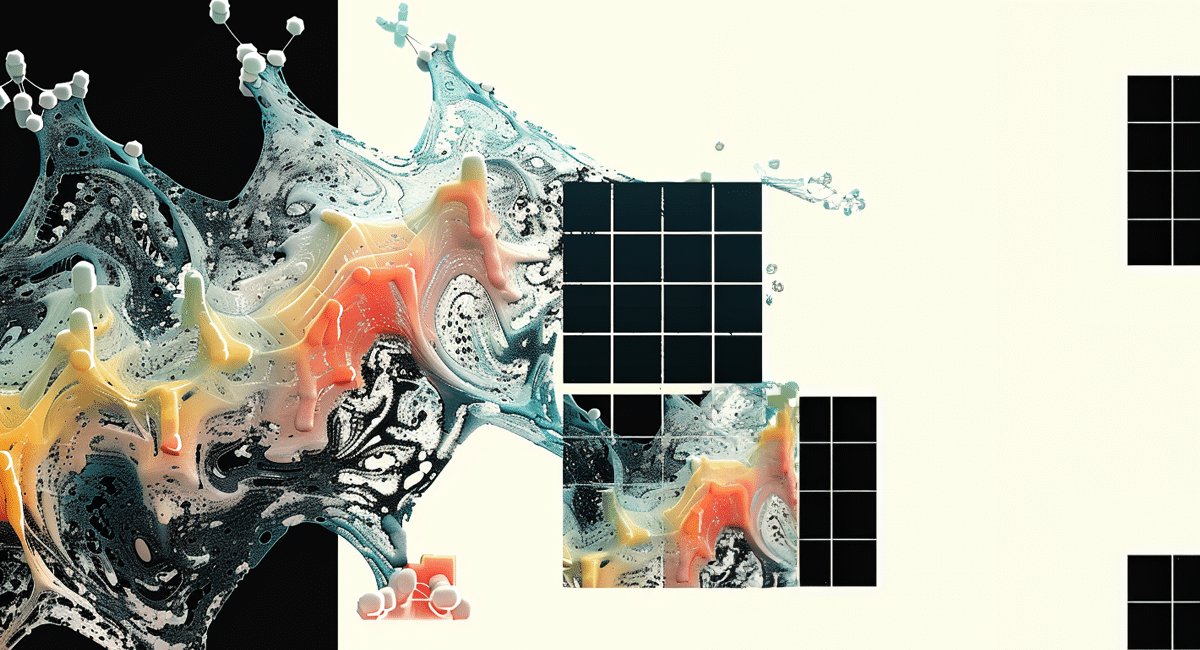As artificial intelligence continues to push boundaries and redefine industries, Generative Adversarial Networks (GAN) have emerged as a game-changer. GANs are transforming the way we generate creative content, from artwork to music, and are revolutionizing fields such as healthcare, art, entertainment, and manufacturing.
GANs enable the creation of synthetic content so realistic it is often indistinguishable from human-generated creations. Whether you’re seeking to enhance your creative process, improve diagnostic accuracy, optimize product design, or advance research in the sciences, GANs offer the tools to unlock new possibilities.
This comprehensive guide is designed to unravel the potential of GAN technology for you. We’ll discuss how they work, their guiding principles, real life applications, upcoming advancements, and ethical considerations.
What are Generative Adversarial Networks (GAN)?
Generative Adversarial Networks use a unique approach to generating new data by pitting two neural networks against each other in a competitive setting. One network attempts to create new data. The other network attempts to discern whether or not it’s fake. Through repeated training, both networks become better at their jobs.
This adversarial relationship leads to a mutually beneficial learning process. This iterative feedback loop drives the GAN towards generating high-quality data that is progressively harder for the discriminator to discern.
By harnessing the power of this adversarial interplay, GANs have revolutionized the field of AI, enabling the creation of realistic images, videos, and other complex data forms. The competition between the generator and discriminator within GANs forms the cornerstone of their effectiveness and ability to generate novel, realistic data.

Deep Dive into How GANs Work
Generative Adversarial Networks consist of two main components: the generator network and the discriminator network. These networks work in tandem to generate realistic data and evaluate its authenticity.
The Generator
The generator network is responsible for creating new data samples. It takes random noise or a latent vector as input and generates synthetic data that resembles the target data distribution. In simpler terms, you can think of the generator as an artist trying to create a masterpiece from scratch.
The Discriminator
On the other hand, the discriminator network acts as a detective or critic. Its role is to distinguish between real data from the training set and the synthetic data produced by the generator. As the generator strives to generate realistic data, the discriminator is trained to become an expert at recognizing genuine from fake. The discriminator’s job is to provide feedback to the generator, helping it improve over time.
Training Process
The training process of GANs involves an iterative feedback loop between the generator and the discriminator. Initially, both networks are relatively weak. The generator creates data that is far from realistic, and the discriminator struggles to differentiate between real and generated samples.
Through repeated iterations, the generator learns from the feedback provided by the discriminator. It continually adjusts its parameters to generate data that fools the discriminator into classifying it as real. The discriminator, in turn, becomes better at distinguishing real from synthetic data as it receives improved examples from the generator.
As training progresses, this back-and-forth process between the generator and discriminator leads to a convergence where the generator produces data that is difficult for the discriminator to discern as fake. At this point, the GAN has reached an equilibrium state known as Nash equilibrium. The generator has learned to generate data closely resembling the target distribution, while the discriminator has become proficient in identifying real and synthetic data with increasing accuracy.
It’s important to note that training GANs can be challenging, as it involves finding the right balance and stability between the generator and discriminator. Researchers are always looking for techniques to improve training stability and address issues such as mode collapse, where the generator’s output becomes limited.
By harnessing this adversarial interplay, GANs have revolutionized the field of generative modeling, enabling the creation of realistic images, videos, and other complex data forms.

Operational Principles of Generative Adversarial Networks
Now that you understand how GANs work, let’s talk about their operational principles. These concepts will help you understand what GANS aim to achieve.
Discriminator Optimization
The discriminator network aims to correctly classify real and fake data samples. It is trained using techniques such as binary cross-entropy loss to update its weights and biases. The goal is for the discriminator to become an effective and accurate detector of fake data.
Generator Optimization
The generator aims to create data samples that can fool the discriminator. It is trained using techniques like backpropagation, where the gradients of the discriminator’s outputs with respect to the generator’s inputs are used to update the generator’s weights and biases. The objective is for the generator to produce data samples that are indistinguishable from real data.
Adversarial Feedback Loop
The generator and discriminator networks engage in an adversarial feedback loop. The discriminator provides feedback to the generator through the probability scores. The generator uses this feedback to adjust its parameters and improve the realism of the generated data.
Mini-Batch Training
GANs are typically trained using mini-batches of data samples. Each mini-batch consists of a combination of real and fake samples. This approach helps in stabilizing the training process and improving the convergence of the networks.
Regularization Techniques
Various regularization techniques are used to prevent overfitting and improve the quality of generated samples. Examples include L1 or L2 regularization, dropout, and batch normalization.
Architectural Choices
Different architectural choices can be made for the generator and discriminator networks, such as using feed-forward neural networks, convolutional neural networks (CNNs), or recurrent neural networks (RNNs). The network architectures and hyperparameters are often optimized through experimentation.
Iterative Learning
GANs operate on the principle of iterative learning. Feedback loops drive their improvement over time. These feedback loops enable GANs to reach an equilibrium state where the discriminator becomes unable to distinguish between real and generated data.

During the training process, GANs update both networks. The initial generator output is usually pretty bad – far from the quality of the real data.
However, as the training progresses, the discriminator provides feedback to the generator by indicating the flaws and inconsistencies in the generated data. This feedback serves as a signal for the generator to adjust its parameters and improve its output.
Similarly, the discriminator receives feedback in the form of labeled samples, where real data is labeled as genuine and generated data as fake. The discriminator incorporates this feedback to refine its ability to differentiate between real and generated data, gradually becoming more discerning.
The equilibrium state is reached when the generator’s output becomes indistinguishable from real data, leading to the discriminator being unable to correctly classify the samples. At this point, the GAN has learned the underlying data distribution and can effectively generate data that is remarkably similar to real-world instances.
From Theory to Practice – A GAN Training Scenario
To better understand how Generative Adversarial Networks work in practice, let’s explore a practical example of image-to-image translation using GANs. In this scenario, we will focus on transforming grayscale images into colored versions.
1. Data Collection and Preprocessing
Gather a dataset consisting of grayscale images and their corresponding colored counterparts. Preprocess the data, ensuring consistent sizing and alignment between the grayscale and colored images.
2. Network Architecture
Design the architecture of the generator and discriminator networks specifically for image-to-image translation. The generator network will take grayscale images as input and generate colored images. The discriminator network will evaluate the authenticity of the generated colored images and the real colored images.
3. Training Initialization
Initialize the weights and biases of both networks randomly. Generate initial colored images using the generator and compare them to the real colored images using the discriminator.
4. Training Progression
During each iteration, feed grayscale images to the generator and produce colored images. Compare the generated colored images with real colored images using the discriminator. Calculate adversarial loss based on the discriminator’s ability to correctly classify the generated and real colored images.
Use backpropagation and optimization techniques, such as stochastic gradient descent, to update the weights and biases of both networks. Repeat this process, allowing the networks to learn and improve their performance over time.
5. Progressive Improvement
Initially, the generator’s output may be far from realistic, and the discriminator may easily distinguish between real and generated colored images.
As training progresses, the generator learns to produce colored images that closely resemble the real ones. The discriminator also becomes more adept at discerning the differences between real and generated colored images.
With each iteration, the generator receives feedback from the discriminator and adjusts its parameters to generate more convincing colored images.
This back-and-forth process between the generator and discriminator drives the GAN towards producing reliable fake data that is difficult for the discriminator to distinguish.
6. Evaluation and Deployment
Assess the quality of the generated colored images through visual inspection and quantitative metrics such as peak signal-to-noise ratio (PSNR) or structural similarity (SSIM). Once the desired level of quality is achieved, deploy the trained GAN model for real-world applications.
This practical example illustrates the progression of GAN training toward generating reliable synthetic content. Through the iterative feedback loop between the generator and discriminator, GANs are capable of producing outputs that closely resemble the target data distribution, enabling impressive transformations like image-to-image translation.
GAN Variations
Generative Adversarial Networks have given rise to numerous variations, each tailored to specific tasks and applications. Let’s delve into some prominent GAN variants and explore their unique characteristics.
Vanilla GAN
These are the foundation of GANs. Vanilla GANs consist of a generator and a discriminator network engaged in a typical adversarial game. The generator aims to produce realistic data, while the discriminator tries to distinguish between real and generated data.
Conditional GAN (cGAN)
cGANs introduce additional conditioning variables to guide the data generation process. By conditioning the generator on specific information, such as class labels or input images, cGANs enable targeted data generation.
Deep Convolutional GAN (DCGAN)
DCGANs incorporate deep convolutional neural networks (CNNs) into GAN architectures. They use convolutional layers in both the generator and discriminator. This supports the generation of high-resolution and realistic images.
Super-Resolution GAN (SRGAN)
SRGANs address image super-resolution, which involves enhancing image quality and resolution. They generate high-resolution images from low-resolution inputs, which improves image details and sharpness.
Laplacian Pyramid GAN (LAPGAN)
LAPGANs operate in a hierarchical manner, generating images at multiple scales. They use a pyramidal structure to successively refine lower-resolution images, capturing finer details and improving overall image quality.
TextGAN
TextGANs specifically target the generation of textual data. They are unique because of their ability to tackle the intricacies of text, such as the complexities of language syntax, semantics, and the need to produce coherent and contextually relevant text sequences.
Video GAN (VGAN)
VGAN is a model designed for generating realistic video sequences. It uses adversarial training, where a generator creates videos and a discriminator evaluates them, to produce high-quality video clips.
CycleGAN
CycleGAN is used for image-to-image translation. It learns to convert images from one domain to another without paired examples, using cycle-consistency losses to ensure meaningful translations.

GAN Applications Across Industries
Generative Adversarial Networks have applications across a wide range of industries. From image generation to 3D modeling, GANs offer their potential for innovation and problem-solving. Let’s explore some notable use cases that highlight the broad applicability of GANs:
Image Generation and Editing
GANs have revolutionized image synthesis, enabling the generation of realistic and novel visuals. They find applications in creative industries, such as graphic design, fashion, and advertising, for creating stunning visuals and product prototypes.
Video Game Development
GANs are increasingly used in video game development for generating high-quality graphics, textures, and characters. By leveraging GANs, game developers can accelerate the creation process and enhance the immersive experience for players.
Healthcare and Medical Imaging
GANs have shown tremendous potential in medical imaging tasks, including medical image synthesis, segmentation, and anomaly detection. GANs enable the development of realistic medical images for training AI models and assist in diagnosing diseases.
Fraud Detection and Cybersecurity
GANs have been employed to detect fraud and anomalies in various domains, such as finance and cybersecurity. GANs can learn patterns and identify unusual behavior, helping organizations proactively identify and mitigate fraudulent activities.
Energy Optimization
GANs offer solutions for energy optimization and conservation. They can simulate energy consumption patterns, optimize energy management systems, and provide insights for renewable energy integration planning.
These are just a few examples of how GANs are making an impact in industries worldwide. The versatility of GANs allows for a wide array of applications, ranging from creative pursuits to complex problem-solving in critical sectors. As GAN research continues to advance, we can expect to see further innovations and practical implementations emerging across industries.
Advancements and Ethical Considerations
GAN models have witnessed significant advancements in recent years, pushing the boundaries of generative modeling. Let’s explore some notable advancements and touch upon their ethical considerations.
First, let’s look at some recent advancements in GAN Models:
- Progressive GANs introduced a training technique that increases the complexity of generated samples. This allows them to create high-resolution images.
- StyleGAN improved control over image generation by separating the model’s style and content. This allows for fine-grained manipulation of generated images.
- BigGAN focused on generating high-fidelity images, leveraging larger models and more powerful architectures to achieve remarkable realism.
- StarGAN went beyond image generation and enabled multi-domain image-to-image translation, broadening the scope of GAN applications.
- GANs have been applied to medical imaging, drug discovery, and scientific data synthesis, aiding in research and diagnosis.
The future holds exciting possibilities for GANs. Researchers are actively exploring advancements, including improved training stability, capabilities for unstructured data like music, hybrid models that combine GANs with other AI techniques, and innovations to make GANs context-aware, allowing generated samples to incorporate environmental or situational factors.
But like all new technologies, there are some ethical considerations to consider.
- GAN-generated deep fakes raise concerns about misinformation, identity fraud, and potential harm to individuals or reputations.
- GANs can reproduce copyrighted content, which will require discussions around intellectual property rights.
- If training data contains bias, GANs may inadvertently amplify that bias, leading to ethical concerns in applications like facial recognition.
- The generation of synthetic data raises questions about data privacy, consent, and responsible handling of personal information.
To address these ethical considerations, researchers and policymakers are exploring various approaches, including ethical frameworks, transparent practices, and regulatory measures to ensure responsible development and use of GANs.
GANs and Your Work
Generative Adversarial Networks have revolutionized machine learning and generative modeling. The advancements in GAN models, along with their practical applications, have opened up new possibilities for creativity, problem-solving, and data synthesis.




